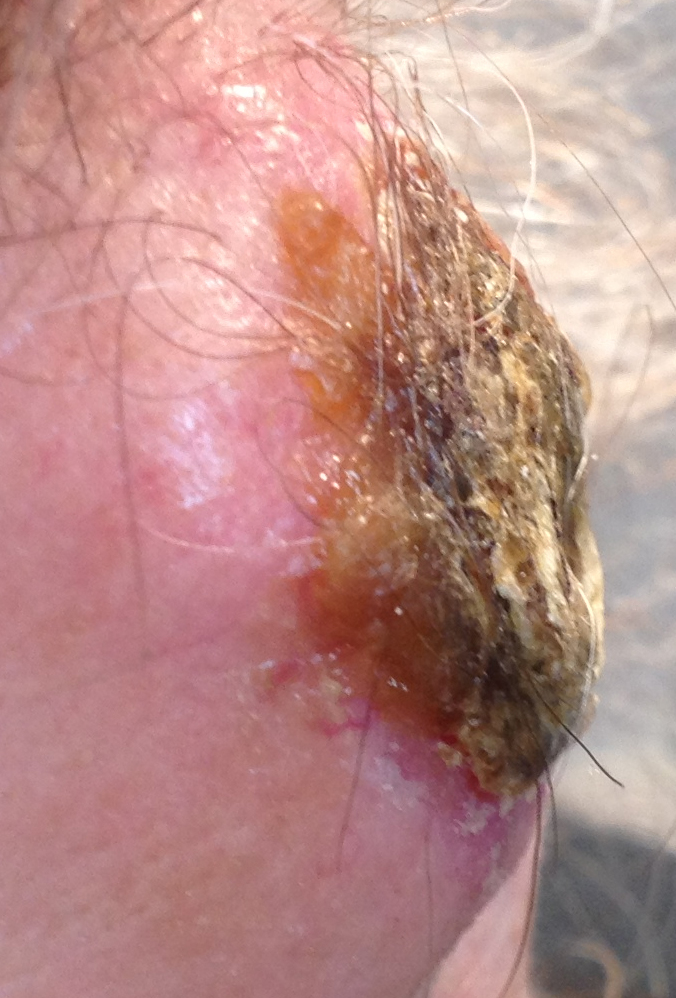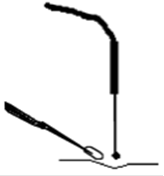Squamous Cell Carcinoma
Squamous Cell Carcinoma: The Second Most Common Cancer in Man
A. DEFINITION
Squamous cell carcinoma is a malignant tumor of the cells of the epidermis which make the protective layer of the skin called keratin. Unlike its counter part (Basal cell carcinoma) Squamous cell carcinoma has the propensity to metastasize to regional and distant sites. Squamous cell carcinoma is the second most common human skin cancer.
B. HOW IT BEGINS
Most lesions begin as a plaque that may be covered with scale, crust, or ulceration. Often reddish in color, usual squamous cell cancer can appear as a white thickening of the skin or mucous membrane. The tumor usually grows in areas exposed to the sun such as the face, arms, back, and legs. Precancerous lesions such as actinic keratoses or actinic cheilitis are usually seen prior to malignant transformation. Symptoms include swelling, redness, and discomfort. If the tumor involves the nails, atrophy or loss of the nail may result. Lymph node involvement can lead to small lumps felt in the adjacent drainage area. SCC’s of the lip are ones most likely to spread.
C. HOW IS IT DIAGNOSED ? Diagnosis of squamous cell carcinoma is made on the basis of gross physical appearance, and a biopsy of the lesion with subsequent microscopic examination. squamous cell carcinoma can usually be diagnosed by physical examination alone, but Dr. Jacobs confirms the diagnosis by cutaneous biopsy. Under the microscope, the biopsy shows classic findings.
D. WHAT CAUSES IT ?
The Sun Most often, the squamous cell carcinoma will not arise until 20 to 40 years after the causative sun exposure. Squamous cell carcinomas often arise in actinic keratoses, actinic cheilitis, or cutaneous horns (ask for Dr. Jacobs education sheet on precancers). This is the reason that actinic keratoses should be treated. Patients with fair complexions, red hair, blue eyes, and those that tend to burn easily in the sun are at a particularly high risk. Other risk factors include a history of ionizing radiation, exposure to carcinogenic chemicals, and various forms of injury to the skin. Areas of chronic inflammation such as those seen with thermal burns, leg ulcers, and lupus may also predispose malignant transformation. As with other cancers, immunosuppression may also increase one's risk of squamous cell carcinoma. Patients with organ transplants or on immunosuppressive therapy are at a greater risk. Squamous cell carcinomas may occur at sites of previous insect bites, burns, and infections. There are syndromes, albinism and xeroderma pigmentosa in which the individuals develop frequent basal and squamous cell carcinomas. Most patients with squamous cell carcinoma are over 65 years old at the time of diagnosis, and squamous cell carcinomas tend to occur in men more frequently than women. Occasionally, it is very possible to find squamous cell carcinomas in young adults with a history of sunburns.
E. HOW DOES IT PROGRESS ?
This cancer frequently starts as a precancerous lesion such as Actinic keratoses. Transformation into a cancer takes place and with time the tumor invades the dermis leading to local and even distant metastasis. The key warning feature is a thickening or swelling and redness extending beyond the lesion itself. As the tumor enlarges a nodule with a central ulceration becomes evident. Beneath the ulceration is a whitish or yellowish necrotic base which when removed leaves a crater like defect. Frequently these cancers have crusts or scabs over them which tend to bleed if repeatedly traumatized. Areas of chronic inflammation have a high rate of metastasis ranging anywhere from 10% to 30%. Although tumors that occur secondary to actinic keratosis tend to be less aggressive than those that primarily arise on their own, all squamous cell cancers can metastasize. For many reasons, some patients tend to defer medical treatment until the tumor has progressed and is well advanced. The tumor can metastasize and if not treated can lead to severe morbidity and death. It's best to have lesions checked as early as possible. It is often difficult to tell just how large the squamous cell carcinoma is, until Dr. Jacobs surgically scrapes away some of the normal skin that may be covering up the cancerous skin. Many patients come to Dr. Jacobs with a small lesion, only to find that the lesion is much larger and is actually traveling underneath the skin.
F. WAYS TO TREAT IT
Treatment of squamous cell carcinoma varies depending on the size and location of the tumor. The primary goal is to completely remove the cancer in the least deforming manner, while still achieving a cure. Surgical therapy: Surgical therapy is the most common method of treating squamous cell carcinomas. First, Dr. Jacobs steriley prepares the site and administers local anesthesia. When the site is sufficiently numbed, Dr. Jacobs begins work.
For early, small, superficial lesions in appropriate locations, one common treatment used today is electrodesiccation and curettage. This technique involves the use of a scraping instrument to remove the tumor, followed by electrocautery or laser surgery to destroy the tumor and stop the bleeding. Each lesion is scraped and burned until all visible evidence of tumor is removed. Dr. Jacobs always takes a safety margin of normal tissue to ensure complete removal. When treating appropriate squamous cell carcinomas by electrodesiccation and curettage, Dr. Jacobs likes to destroy the tumor down to the fat. The wound then goes on to heal on its own. Healing may take a month or more, depending on the size and location. Subsequent follow up is necessary to make sure the tumor does not reoccur. Electrodesiccation and curettage gives excellent results in certain locations and clinical situations. Dr. Jacobs may suggest for you to have electrodesiccation and curettage if your tumor is appropriate for this type of therapy. Excision Another common treatment is surgical excision. In areas of the body where skin is easily stretched and cosmetic result allows, surgical excision can be a good alternative treatment. Dr. Jacobs makes an appropriate incision is made around the tumor, and includes a small safety margin of normal tissue to insure complete removal. The squamous cell carcinoma is then removed, and the sample is sent to pathology for evaluation of margins. Depending on the case, Dr. Jacobs may order either a tangential Moh's path cut , or, a conventional vertical path cut to evaluate the margins of the lesion. The defect is then stitched closed. Depending on the complexity of the wound, Dr. Jacobs may suggest a side to side closure, a skin flap, or a skin graft. Occasionally, the wound is left to heal on its own.
Cryosurgery
Scar Abrasion and Cosmetic Appearance After skin cancer removal, Dr. Jacobs may use a small sanding device to "sand down" the scar, or may perform some other procedure to improve the site. Again, this type of work is exceedingly uncommon, and most patients do very well with just a simple surgical removal. Finally, with all surgical therapies rendered, there is always a small chance of incomplete removal or recurrence. Dr. Jacobs handles each case individually, based on the patient's tumor, the location, the size, the patient's wishes, and overall health. Please understand that skin cancer therapy is often more than on step. The patient may need one or more sessions in order to remove the cancer. Also, the patient may need additional cosmetic work to restore the appearance of the site. Time and patience is needed to achieve the desired result. For example, if an eyebrow or nose is stretched after surgery, a second procedure may be needed to restore the appearance. If a scar is large, a second procedure may be needed to improve its appearance. This all takes time and waiting as the human body takes time to decrease swelling, stretch, and heal after surgery.
Non-surgical therapy: Radiation therapy is a common non-surgical therapeutic modality for squamous cell carcinomas. In selected cases, if surgical excision, curettage, or cryotherapy is not agreeable with the patient's wishes and expectations, and if appropriate, Dr. Jacobs may suggest a referral for radiation therapy. Radiation therapy can give excellent cosmetic and therapeutic results in certain selected cases. Not every case is appropriate for radiation, but radiation therapy can be a viable option for certain individuals. Efudex cream or solution is another common way to treat squamous skin cancers, but it only works for squamous cell in situ type skin cancers.
G. WHAT TO EXPECT
Squamous carcinoma is 95% percent curable if it is caught early enough. In larger lesions that penetrate the deeper tissues the risk of metastasis increases substantially. Once lymph node involvement has occurred the prognosis becomes poor. Approximately 66% of patients with local invasion and almost all those with nodal involvement eventually die from this disease. However, once sun damage has progressed to the point where these lesions have developed, further lesions may appear even without further sun exposure. It is therefore imperative that once you have been diagnosed with cancerous skin lesions, you should closely examine your skin on a regular basis. Also it is extremely important to use preventative measure to decrease the risk of other precancerous or cancerous lesions. If any questionable new lesions occur or old lesions reoccur you should contact Dr. Jacobs as soon as practical.
H. Photos
As a picture is worth a thousand words, here are photos to help you understand SCC:
|
|||||
 |
|
|
 |
 |
|||||||||||
 |
|||||||||||||
    
Home | Dry/Sensitive Skin | Skin Renewal | Skin Complexion & Acne | Dermatology Patient Education |

















